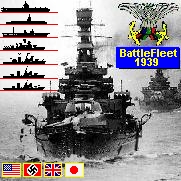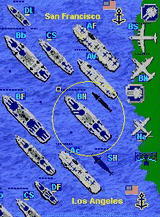See
also:
Third Reich
Organization and people GERMAN ARMY WW2
ORDER OF BATTLE Adolf (Adolph)
Hitler WW2 Victory Defeat Power Luftwaffe History Axis Powers WW2
Pact of Steel Gestapo, SS Panzer Divisions Hermann Goering, Heinrich Himmler, Reinhard Heydrich, Werner Von Braun, Wilhelm Canaris, Walter
Schellenberg, Von Rundstedt, Heinz Guderian, Wilhelm Keitel Field Marshal Erwin
Rommel - Desert Fox German Africa Corps Manstein WW2 German
Generals Otto Skorzeny
(Skorceny) WW2 Commandos Rundstedt WW2 Field
Marshal Nazism Fascism WW2 V1 Rocket - Flying
Bomb V-1 V2 Rocket V-2 Fuhrerbunker - WW2
Forifications Maginot Line WW2 Iron Cross Flak
Battleship Game - WW2 Naval
Strategy: the best choice among aircraft carrier game and submarine games.
Missions and Scenarios:
Pearl Harbor Game
Atlantic Game 1943
Sink Cruisers Game
Midway Game
Iwo Jima Game
US Marines Game
Luftwaffe Game Pacific
Torpedo Game Boats
Bismarck Game Pacific
Destroy RAF Game
Okinawa
Us Navy Submarine Game
Fleet Submarines Game
Kamikaze Game
U Boat Game
Singapore Game
Swordfish Hunt
Patrol Boats
Air Supremacy
Alert
Battleships Game
Java
Defense
Fleet Cruisers Game
Atlantic Island
Coral Sea Game
Iron Sea
Mykonos
Imperial Ocean
Long Convoy
Skagerrak
Target Los Angeles
West Pacific Game
Pacific War Game
Leyte Transport
Emperor Hirohito
Normandy Game
South Pacific Game
Destroy USAF Game
Submarine Games
US Navy Game
Free Hunt Doenitz Game
Free Hunt Spruance Game
Free Hunt Halsey Game
Imperial Navy I
Royal Navy Game
Free Hunt Pearl Harbor Games
Midway II
Kriegsmarine I
Brisbane Convoy
Clear West Coast
Fall Of Australia
Battle For Leyte
Conquer Of Japan
HMAS Perth
Road To Okinawa
Orange Ports
Emperor Defense
Prince Of Wales
San Bernardino
Pacific Race
Heavy Duty
Tokio Express
Operation Sidney
Bomber Operation
Conquer Of Italy
Heavy Cruiser Game
Frigate Hunt
Santa Cruz
Lamansh Game
Azores Transport
Norway Convoy
Invasion
Grossadmiral
Norway Ports
Drang Nach Ost
Convoy Pk30
Ciano Defense
Sir John Tovey
Free Hunt Andrews
Germans On Pacific
Silent Hunt
Antigua
Return To Midway
Kriegsmarine Game II
Royal Air Force Game
F. Hunt Lancaster
Jamamoto Game
Free Hunt USN
Free Hunt Japan
Free Hunt RAAF
Free Hunt U Boat Game
Free Hunt Aircraft Carriers Game
Free Hunt Hawaii
Free Hunt Yamato Game
Free Hunt Iwo Jima Game
Free Hunt Pacific Game
Free Hunt Torpedos
Free Hunt Convoy
Free Hunt Germany
Free Hunt Germany II
Free Hunt Italy
Free Hunt Malaya
Free Hunt Subs Game
Free Hunt B-26 Game
Free Hunt USN 1944
Devil Island
Dragoon Carriers
|
Albert
Speer
Albert Speer (March 19, 1905 - September 1, 1981),
sometimes called 'the first architect of the Third
Reich', was Hitler's chief architect in Nazi Germany.
Although he originally wanted to become a mathematician
when he was young, he ended up following in the footsteps
of his father and grandfather and studied architecture
instead. He studied under Heinrich Tessenow at the
Institute of Technology in Berlin, eventually becoming
Tessenow's assistant. After completing his studies in
1931, he married Margarete Weber. Later that year he was
persuaded by some of his students to attend a Nazi Party
rally, where he found himself mesmerized by the words of
Adolf Hitler. Within weeks he was a member of the Party.
His first commission as a Party member came in 1933 when
Joseph Goebbels asked him to renovate the Propaganda
Ministry. Goebbels was impressed with his work and
recommended him to Hitler, who assigned him to help Paul
Troost renovate the Chancellery in Berlin. Speer's most
notable work on this assignment was the addition of the
famous balcony.
Troost died in 1934, and Speer was chosen to replace him
as the Party's chief architect. One of his first
commissions after his promotion was perhaps the most
familiar of his designs: the Nuremberg parade grounds
seen in Leni Riefenstahl's propaganda masterpiece,
Triumph of the Will. The grounds were based on ancient
Doric architecture of the Pergamum Altar in Turkey, but
magnified to an enormous scale, capable of holding two
hundred and forty thousand people. At the 1934 Party
rally on the parade grounds, Speer surrounded the site
with one hundred and fifty anti-aircraft searchlights.
This created the effect of a "cathedral of
light," as it was called by British Ambassador Sir
Neville Henderson.
| CIA / KGB intelligence game. Run your own operation game.
Travel around the world and set up espionage
game, trade with state secrets, weapon systems,
spy codes, WMD, hire secretaries, agents, lawyers
and soldiers, establish secret agent stations,
cells and bases and search for criminals and
politicians. Involve in agent game. Game contains
more than 40 missions including Nuclear Game,
Cold War Game, Secret Agent, CIA Games, USAF,
Prime Minister, RAF, Bin Laden, Sa |
Nuremberg was also to be the site
of many more official Nazi buildings, most of which were
never built; for example, the German Stadium would have
held another four hundred thousand spectators as the site
of the Aryan Games, a proposed replacement for the
Olympic Games. While planning these buildings, Speer
invented the theory of "ruin value." According
to this theory, enthusiastically supported by Hitler, all
new buildings would be constructed in such a way that
they would leave aesthetically pleasing ruins thousands
of years in the future. Such ruins would be a testament
to the greatness of the Third Reich, just as ancient
Greek or Roman ruins were symbols of the greatness of
their civilizations.
In 1937 Speer designed the German Pavilion for the
World's Fair in Paris, France, which was located directly
across the street from the Soviet Pavilion. It was
designed to represent a massive defense against the
onslaught of communism, although both pavilions were
awarded gold medals for their designs.
Speer was also directed to make plans to rebuild Berlin,
which was to become the capital of a supra-German state
-- Germania. The first step in these plans was the
Olympic Stadium for the 1936 Summer Olympics. Speer also
designed a new Chancellery, which included a vast hall
designed to be twice as long as the Hall of Mirrors in
the Palace of Versailles. Hitler wanted him to build a
third, even larger Chancellery, although it was never
begun. The second Chancellery was destroyed by the Soviet
army in 1945.
Almost none of the other buildings planned for Berlin
were ever built. Berlin was to be reorganized along a
central three-mile long avenue. At the north end, Speer
planned to build an enormous domed building, based on St.
Peter's Basilica in Rome. The dome of the building would
have been impractically large; it would be over seven
hundred feet high and eight hundred feet in diamter,
sixteen times larger than the dome of St. Peter's. At the
southern end of the avenue would be an arch based on the
Arc de Triomphe in Paris, but again, much larger; it
would be almost four hundred feet high, and the Arc de
Triomphe would have been able to fit inside its opening.
The outbreak of World War II in 1939 led to the
abandonment of these plans.
Hitler supposedly had a weakness for the young and
handsome Speer, whose designs were considered expressions
of National Socialist principles. Hitler made him
Minister of Armaments and War Production in 1942 to
replace Fritz Todt, who had been killed in a plane crash.
He worked diligently to increase war production, often
through the use of slave labour, even though it became
more and more obvious that Germany was facing imminent
defeat. However, he also became one of the few Nazi
leaders to stand up to Hitler and his increasingly
maniacal demands. Speer refused to carry out Hitler's
scorched earth policy, and even planned an assassination
attempt in 1945. Despite this, Hitler continued to
consider Speer a friend, and Speer was one of the last
people he spoke to before he committed suicide.
Speer pleaded guilty in the Nuremberg trials after the
war and was sentenced to 20 years imprisonment in Spandau
Prison, West Berlin, largely for his use of slave labour.
His release from prison in 1966 was a world-wide media
event. He published several semi-autobiographical books
until his death in London on September 1, 1981 - exactly
42 years after World War II began. His books such as
Inside the Third Reich provided a unique and personal
look into the personalities of the Nazi era. However,
many critics believe that his books understate his role
in the atrocities of the era.
His son also became a successful architect and was
responsible for the design of Expo 2000 - the world
exposition that took place in Hanover in the year 2000.
He also designed the Shanghai International Automobile
City.
Books about Speer
Albert Speer: His Battle With Truth, by journalist Gitta
Sereny
The Good Nazi: The Life and Lies of Albert Speer, by Dan
van der Vat
|
|
|
| |
|
|
| |
 PC Win. PC Win. |
|
| |
 |
|
| |
Turn-based WW2
naval game, extension to the classic
Submarine game (Battleship game) where
ships/planes/subs can move. Contains plenty of
game missions, game campaigns and 40 ship,
submarine, airplane ana port artillery types,
with combat maps up to 96X96 large.
Soon: also for Android, ipad, iphone
strategy battleship games |
|
| |
|
|
| |
|
|
| |
|
|
| |
Tycoon Strategy
Game - build your own world business empire as an
arms dealer tycoon. Travel around the world,
trade with more than 400 weapon systems, hire
secretaries, bodyguards, lawyers, fighters and
tanks, establish companies and search for
criminals and hostages. |
|
| |
|
|
| |
|
|


